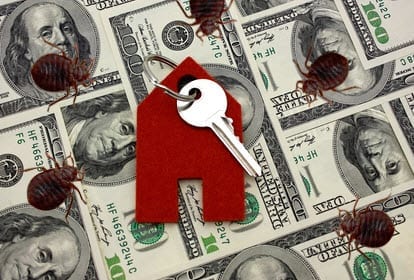According to the “2013 Bugs Without Borders Survey” from National Pest Management Association (NPMA), nearly 100 percent of the pest control companies that responded said they had worked on one or more bed bug infestations in 2012. Bed bugs are found almost anywhere people sleep — homes, hotels, motels and college dorms. Your challenge as a homeowner is that your insurance doesn’t cover the damage done by bed bugs, or any destructive insect.
A Little Bug Causes Big Headaches
They are small, wingless creatures that feed on the blood of people and other animals. They usually don’t move more than a few feet from their hosts. They will infest your mattress, linens and box springs. They may be found in curtains, under tables and dressers. Pest World says bed bugs can be very hard to find, even hiding in electrical switches and behind wallpaper. This also makes them hard to get rid of.
You need to find and exterminate the eggs, adults and juvenile bed bugs. DIY solutions require multiple applications and might not get rid of the immature insects and eggs. Frustrated with the problem, homeowners might use too many chemicals too often. They might also unnecessarily throw out beds, linen, curtains, clothing, tables and chairs and pull wallpaper off of the wall, which creates additional expenses.
Consult with professional services that have experience exterminating bed bugs before attempting any DIY steps.
Insurance Covers Collateral Damage
Unfortunately, your home insurance doesn’t cover damage caused by the bed bugs. Insurance pays for what they consider “sudden” and “accidental” damage to your home, says Insure Me. For example, if a tree limb breaks off during a storm and breaks a window in your home, insurance covers that. But if damage to your home occurs because bed bugs have been living in the house for a month, that damage is not covered.
The insurance company’s position is that you had warning of the damage and could’ve taken steps to prevent it. You don’t have warning of a tree limb breaking in a storm.
Insurance might provide coverage for repair to collateral damage to your home. For example, termites infest a wall and chew through a floor joist. The joist breaks, the floor sags and a wall settles and cracks. Your insurance might cover the wall repair because it was “sudden and accidental,” but you’ll be responsible for replacing the termite-damaged floor joist.
Other Pest Issues
A number of other pests can damage your home, and insurance help you:
- Termites – These are like little machines that chew constantly through the wood structures of your house. All day and night they chew through floors, walls and the ceiling. You might not know they are in your house unless a wood structure breaks, or they are spotted during a professional pest inspection. Every homeowner should schedule at least an annual inspection for termites. If you live in an area where termite populations are heavy, your pest control professional might recommend inspections more often. It will also recommend preventive measures.
- Carpenter ants and powder post beetles – These are wood-damaging insects that make their nests in the wood. They lay eggs that hatch and become mature adults. They bore little tunnels through the wood and over the years, it weakens until it finally breaks. If you see tiny piles of unexplained sawdust, this could indicate you’ve got these pests.
- Bats, rats, squirrels and birds – Fortunately, these creatures are large enough that you can hear their activities in your ceilings and walls. The damage is usually from nesting activity and can occur over a long period.
Brad Goodwin
Brad has worked on urban renewal projects in Colorado, New Mexico and Arizona.
